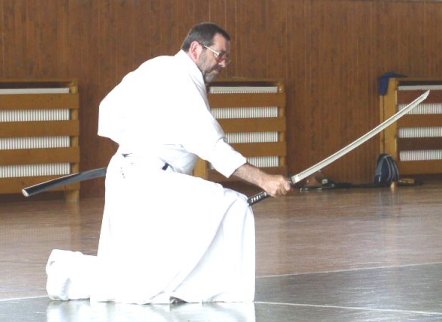|
Tanren Bō
A is a bat used in aikido for strength and suburi training. Despite being only overall, with 10 inches for the handle, the "blade" is a large lump of rectangular wood, with its cross-section being a square with dimension of three square inches, and has an overall weight of 4 to 7 lbs. By designating one corner as edge, an aikidoka can use it as an even heavier suburitō, practice suburi, kata ''Kata'' is a Japanese word ( 型 or 形) meaning "form". It refers to a detailed choreographed pattern of martial arts movements made to be practised alone. It can also be reviewed within groups and in unison when training. It is practised ..., hasuji (edge-angle) and tomei (swing stopping), and learn the bounce-back of the sword by practising against tenu-ichi, now typically a tyre stood upright on a concrete base. As it is designed towards aikido and strength training, specifically for getting used to the weight of a heavy-handled object, it does not resemble a swor ... [...More Info...] [...Related Items...] OR: [Wikipedia] [Google] [Baidu] |
Aikido
Aikido ( , , , ) is a modern Japanese martial art that is split into many different styles, including Iwama Ryu, Iwama Shin Shin Aiki Shuren Kai, Shodokan Aikido, Yoshinkan, Renshinkai, Aikikai and Ki Aikido. Aikido is now practiced in around 140 countries. It was originally developed by Morihei Ueshiba, as a synthesis of his martial studies, philosophy and religious beliefs. Ueshiba's goal was to create an art that practitioners could use to defend themselves while also protecting their attackers from injury. Aikido is often translated as "the way of unifying (with) life energy" or as "the way of harmonious spirit". According to the founder's philosophy, the primary goal in the practice of aikido is to overcome oneself instead of cultivating violence or aggressiveness. Morihei Ueshiba used the phrase to refer to this principle. Aikido's fundamental principles include: (entering), , (breathing control), (triangular principle) and (turning) movements that redirect the oppo ... [...More Info...] [...Related Items...] OR: [Wikipedia] [Google] [Baidu] |
Suburi
is a Japanese word for practice swings used in sports such as baseball, tennis, golf, and in martial arts. Outside Japan, the word is used exclusively for repetitive individual cutting exercises used in Japanese martial arts such as kendo, aikido, iaidō, and kenjutsu. Often a shinai (for kendo), bokken, suburitō, or even tanren bō are used. An iaitō or shinken can also be used, albeit rarely. Some common types (these can vary between styles): ; : holding the weapon with only the left hand (which is supposed to be used as the power hand) ; : rapid suburi where you cut on the forward motion and assume jodan on the return motion, feet should glide on the floor. Sometimes called choyaku-men ; : incorporating a coordinated jumping like movement with the strike ; : strikes with back swings that almost touch ones lower back and forward swings which almost touch the floor ; : alternating diagonal strikes, cutting across the opponent's torso, starting with a cut to the left ; : strike ... [...More Info...] [...Related Items...] OR: [Wikipedia] [Google] [Baidu] |
Suburitō
A is a type of ''bokken'', a wooden practice sword originating in Japan and used in Japanese martial arts. ''Suburi'' (素振り; literally, "basic or plain swing") means "practice swing"; a ''suburitō'' is therefore used to practice sword-swinging. Description and use The suburitō is much thicker at the blade than the handle which makes the suburitō much heavier than a normal bokken. Suburitō are used for practicing ''suburi'' (sword swinging exercises) and ''kata'' (prearranged exercises). The weight of the suburitō is used for strengthening and conditioning in addition to development of spirit. The suburitō is used to perfect individual technique as well. A ''suburitō'' is commonly around 115 cm (45 in) in length, with a mass of 1 kg (2.2 lb). However, these bokuto can vary widely in size and weight. Suburitō generally do not include a guard. Legend has it that Miyamoto Musashi carved a bokken that resembled a ''suburitō'' out of a boat oar as he ... [...More Info...] [...Related Items...] OR: [Wikipedia] [Google] [Baidu] |
Kata
''Kata'' is a Japanese word ( 型 or 形) meaning "form". It refers to a detailed choreographed pattern of martial arts movements made to be practised alone. It can also be reviewed within groups and in unison when training. It is practised in Japanese martial arts as a way to memorize and perfect the movements being executed. Korean martial arts with Japanese influence (hapkido, Tang Soo Do) use the derived term ''hyeong'' (hanja: 形) and also the term ''pumsae'' (hanja: 品勢 hangeul: 품새). Kata are also used in many traditional Japanese arts such as theatre forms like kabuki and schools of tea ceremony (''chadō''), but are most commonly known in the martial arts. Kata are used by most Japanese and Okinawan martial arts, such as iaido, judo, kendo, kenpo, and karate. Background Kata originally were teaching and training methods by which successful combat techniques were preserved and passed on. Practising kata allowed a company of persons to engage in a strug ... [...More Info...] [...Related Items...] OR: [Wikipedia] [Google] [Baidu] |

